site search
online catalog
INSCRIBED AMES FOOT OFFICER’S SWORD OF LT. CHARLES H. TOBEY, 58th MASS, WIA SPOTSYLVANIA AND PETERSBURG; POW POPLAR GROVE CHURCH

$4,800.00
Quantity Available: 1
Item Code: 1052-1132
Shipping: Determined by Method & Location of buyer
To Order:
Call 717-334-0347,
Fax 717-334-5016, or E-mail
Charles Henry Tobey did three tours of duty during the war and this sword dates to his service as an officer, from January 1864 to muster out in July 1865, in the 58th Massachusetts, a regiment in the 1st Brigade, 2nd Div., 9th Army Corps with the Army of the Potomac that lost 10 officers and 129 enlisted men in killed or mortally wounded alone in the continual fighting of Grant’s 1864-65 campaign, with CW Data listing 50 dates at which they took casualties of some sort, including Tobey, who was wounded twice and later taken prisoner. When his widow asked for a pension increase in 1926 she cited his two wounds, time as a prisoner of war, and participation in thirteen battles.
In form this is the standard US M1850 Foot Officer’s Sword, but with a more robust metal scabbard, a consideration by any officer for use in the field, and is in very good condition. The hilt has the standard pommel with leaf decoration along the edge with central rosette, and floral open-work guard with scrolling quillon. The brass has an untouched mellow patina with some light traces of the gilt finish. The gray sharkskin grip is intact, with no holes, nice color and surface with the nodes intact. The twisted, gilt brass binding wire is in place. The blade pad is missing from the underside of the guard, which shows traces of gilt, more strongly where the pad had covered it. The quillon appears slightly bent forward. The scabbard mounts match the patina of the hilt. The carrying rings are in place. The drag shows some dents and dings, showing a tad brighter from rubbing and the drag blade shows wear. The scabbard body is smooth metal with only minor surface freckling, no dents, dings or rust, and full coverage of its original blue oxidizing just slightly toward plum. The upper mount is marked “AMES MFG. CO. / CHICOPEE / MASS” on the reverses. The obverse is inscribed “C.H.T.” in script over “58 Regt. Mass. Vols.” also in script- there is no ambiguity in identifying the officer as Charles H. Tobey, the only officer in the regiment with those initials.
Much of the blade etching vivid against the bright frosted ground terminating in sunburst flame points at the upper end of the fuller, though there are scattered gray spots and areas of oxidation, most at the base of the blade on the obverse and the base and upper portion of the blade on the reverse. This affects the etched Ames address above the obverse ricasso, which is faint and not legible, though in general the spotting is more evident on the reverse than the obverse. The obverse etching uses loose, flowing leafy vines at the bottom, leading up to a central floral entwined trophy of arms, mainly pikes, with a spread-winged eagle overhead clutching arrows and olive branch, with dry needle etched E Pluribus Unum ribbon scroll above, followed by more, loose floral and vine motifs to the conclusion of the panel. The reverse employs a long, scrolling floral vine at base, but follows it with a script “US,” and then a more elaborate trophy of arms including a shield, cannon a trumpet along with pikes and a banner, concluding with a leafy vine at the end of the panel.
In addition to a binder of research, the sword is accompanied by a Massachusetts backmarked CDV of Tobey signed and dated in pencil on the reverse April 1864. He is shown standing, ¾ length, in uniform, his hand thrust in his lapel in Napoleonic fashion, wearing sash, sword belt, and Model 1850 Foot Officer’s Sword. It also comes with a copy of the regimental history- which is short, but offers a detailed account of the regiment’s service, with a roster. In addition, Tobey was also the subject of a short article and a notice in North South Trader. The latter pictures this sword and CDV soon after its acquisition by a collector. The former includes a photo of a Smith and Wesson presented to him as an officer and several photographs of Tobey, who was not camera-shy, including portraits in his militia uniform and as a sergeant during his second period of service, in addition to a companion view of the CDV coming with the sword. (We think the article wrongly dates their view to his service as a captain- the CDV has no tax stamp, the position of his belt and sash make clear it is taken at the same sitting, and the inscription on the back is April 1864.) The presentation of a revolver to him suggests the sword might have been given at the same time, but although the sword is a very nice one, it is not elaborate and the simplicity of the inscription and the metal scabbard makes strikes us much more as something Tobey purchased for himself in the expectation of active field service- which he certainly got.
Tobey’s first service qualified him as a “Massachusetts Minute Man of ’61.” He had been born in New Bedford, MA, in 1840 and was a 21 year-old clerk when he enlisted in Company L of the 3rd Massachusetts Volunteer Militia Infantry on April 16, 1861. Originally organized as a militia company named the New Bedford Guard in 1852, almost all had volunteered for active service in response to the Governor’s preparatory orders of January 1861. Whether he was a longtime member or not, on April 16 he enlisted as a private in the company, which had been activated late the day before, and sailed with them for Virginia on April 18 for three months service. They arrived at Fortress Monroe on April 20, and were assigned there as part of its garrison, welcoming fugitive slaves and taking part in the destruction of the Gosport Navy Yard to prevent it falling into Rebel hands. They spent a brief time at Hampton, VA, before sailing for home July 19 and mustering out July 22.
Tobey’s second service was also in the 3rd Massachusetts, activated a second time in response to the President’s August 1862 call for 300,000 militia for ninety-days service. They were organized and brought up to war strength at Camp Joe Hooker in Lakeville, MA, and mustered in on Sept. 23 and 26, with Tobey mustering in as a sergeant in Company E, likely based in part on his previous military experience. The regiment embarked for North Carolina on October 22, reached Beaufort on Oct. 26 and then went by rail to Newbern. They took part in the Goldboro expedition and were present in the fighting at Kinston, Whitehall and Goldsboro, though with little loss. In January 1863 they officially became part of the 18th Corps, and were posted to the Fort Totten in the defenses of Newbern. From there they took part in some small expeditions, including for the relief of Washington, N.C., before returning home in June for muster out on June 26. They had lost one man killed or mortally wounded, and another 17 to accident or disease.
Tobey’s third and last service was more serious. He enrolled in the 58th Mass Infantry, a regiment organized at Readville, MA, and mustered into service from January 14 through April 18, 1864. He was commissioned a 2nd lieutenant in Company D to date January 22, 1864, and on March 3 he was promoted to 1st lieutenant of the same company. The regiment left the state April 28, just eight companies strong, and reached Bristoe Station, VA, on the evening of May 2, where it was assigned to the 9th Corps.
Just two days later Grant advanced, and on May 6 the regiment suffered its first casualties, 7 killed, 23 wounded, and 4 missing at the Wilderness. At Spottsylvania they took part in the assault on Hill’s Corps, losing 13 killed, 90 wounded, and 2 missing, with Tobey among the wounded, suffering from a bruised foot, likely from a spent round or shell fragment that put him in the hospital for two weeks. This would have put him out of action for the fighting at the North Anna and Totopotomoy where the regiment was lightly engaged in late May, but may have put him back in the line on June 3 when they were heavily engaged in the attack at Bethesda Church, losing another 95 in killed and wounded, and in subsequent fighting until June 12, another 30 men in killed wounded and missing.
The regiment crossed the James on June 15 to take part in attacks on Confederate lines east of Petersburg on June 17, resulting in 2 killed, 22 wounded, and 1 missing. Tobey was again among the wounded, this time hit in the left hand by a gunshot that mangled three fingers, including the little finger, which was amputated by a surgeon. He was given a 30-day leave on June 21 to return home and recover, though a doctor’s affidavit on July 21 seems to have extended it for another twenty days, putting him back with regiment around August 10, at which point the regiment was serving in the trenches and on picket lines, and had suffered yet further losses in the Battle of the Crater.
By CWData’s listings the regiment suffered only a couple of men wounded in August and early September, but on September 30 they were again in heavy action the Battle of Poplar Grove Church, also known as Peeble’s Farm. This was an attack on the western end of Lee’s lines coordinated with an attack on the eastern end (the Battle of Chaffin’s Farm.) Confederate forces diverted to that eastern attack returned in time to slam into 9th Corps which was not fully connected with the 5th Corps. Only a dozen or so the 58th made it out, with the regiment, already understrength, losing another 2 killed, 10 wounded and 99 captured, among them Tobey. He was incarcerated at Richmond and then at Salisbury, NC, until returned to Richmond and paroled on Feb. 22, 1865. He spent about ten days in the hospital and was given a thirty-day leave, rejoining the regiment about April 14 near Burkesville and was officially mustered out as a 1st Lieutenant and mustered back in as Captain a day later, though with effective rank dating back to June 18, 1864, and assumed command of Company K (one of the final two companies joining the regiment in the field) on April 30. He remained with the regiment until their muster out at Washington on July 14.
Tobey had married in October 1863 and returned to work in Massachusetts. CWData says he worked in the shipping department of a shoe factory. He gave his occupation as a clerk when he signed up, so it makes sense he was working in factories or mills. By the census of 1880, however, he had risen to superintendent in a woolen mill in Middleborough, where he died in 1907. He was interred back in New Bedford, survived by his wife and at least two children. [sr][ph:L]
~~~~~~~~~~~~~~~~~~~~~~~~~~~~~~~~~~~
THIS ITEM, AS WITH ALL OTHER ITEMS AVAILABLE ON OUR WEB SITE,
MAY BE PURCHASED THROUGH OUR LAYAWAY PROGRAM.
CLICK HERE FOR OUR POLICIES AND TERMS.
THANK YOU!
Inquire About INSCRIBED AMES FOOT OFFICER’S SWORD OF LT. CHARLES H. TOBEY, 58th MASS, WIA SPOTSYLVANIA AND PETERSBURG; POW POPLAR GROVE CHURCH
For inquiries, please email us at [email protected]
Most Popular
Historical Firearms Stolen From The National Civil War Museum In Harrisburg, Pa »
Theft From Gravesite Of Gen. John Reynolds »
Selection Of Unframed Prints By Don Troiani »
Fine Condition Brass Infantry Bugle Insignia »
British Imported, Confederate Used Bayonet »
Scarce New Model 1865 Sharps Still In Percussion Near Factory New »
featured item
JULY 1863 LETTER BY FAMED COL. JOSHUA LAWRENCE CHAMBERLAIN OF THE 20TH MAINE
This letter comes from the hand of famed Colonel Joshua Lawrence Chamberlain of the 20th Maine and is written to his wife from his shelter tent in the Shenandoah Valley near Front Royal. Dated July 24th 1863, Col. Chamberlain details the fight of… (557-250). Learn More »
site search
Upcoming Events
May 16 - 18: N-SSA Spring Nationals, Fort Shenandoah, Winchester, VA Learn More »






















